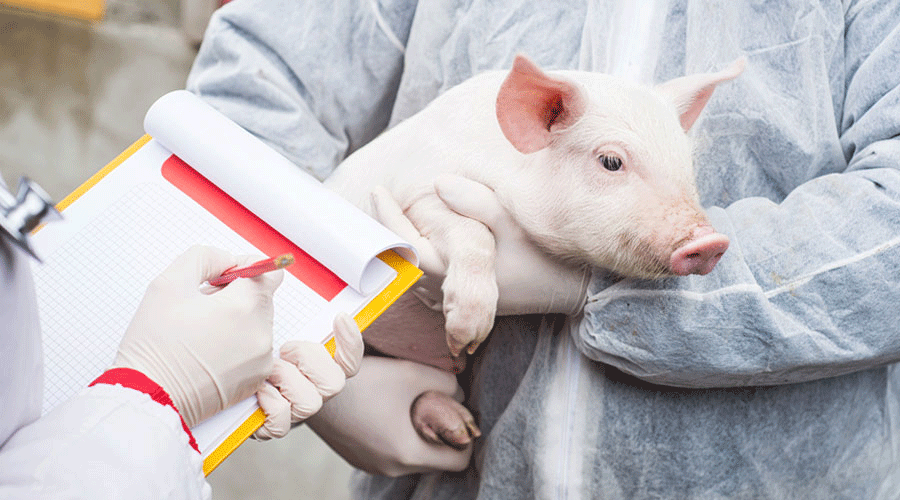The pigs had been lying dead in the lab for an hour — no blood was circulating in their bodies, their hearts were still, their brain waves flat. Then a group of Yale scientists pumped a custom-made solution into the dead pigs’ bodies with a device similar to a heart-lung machine.
What happened next adds questions to what science considers the wall between life and death. Although the pigs were not considered conscious in any way, their seemingly dead cells revived. Their hearts began to beat as the solution, which the scientists called OrganEx, circulated in veins and arteries. Cells in their organs, including the heart, liver, kidneys and brain, were functioning again, and the animals never got stiff like a typical dead pig.
Other pigs, dead for an hour, were treated with ECMO, a machine that pumped blood through their bodies. They became stiff, their organs swelled and became damaged, their blood vessels collapsed, and they had purple spots on their backs where blood pooled.
The group reported its results Wednesday in Nature.
The researchers say their goals are to one day increase the supply of human organs for transplant by allowing doctors to obtain viable organs long after death. And, they say, they hope their technology might also be used to prevent severe damage to hearts after a devastating heart attack or brains after a major stroke.
But the findings are just a first step, said Stephen Latham, a bioethicist at Yale University who worked closely with the group. The technology, he emphasised, is “very far away from use in humans”.
The group, led by Dr Nenad Sestan, professor of neuroscience, comparative medicine, genetics and psychiatry at the Yale School of Medicine, was stunned by its ability to revive cells. “We did not know what to expect,” said Dr David Andrijevic, also a neuroscientist at Yale and one of the authors of the paper. “Everything we restored was incredible to us.”
Others not associated with the work were similarly astonished.
“ It’s unbelievable, mind-blowing,” said Nita Farahany, a Duke law professor who studies ethical, legal and social implications of emerging technologies. And, Dr Farahany added, the work raises questions about the definition of death.
“We presume death is a thing, it is a state of being,” she said. “Are there forms of death that are reversible. Or not?”
The work began a few years ago when the group did a similar experiment with brains from dead pigs from a slaughterhouse. Four hours after the pigs died, the group infused a solution similar to OrganEx that they called BrainEx and saw that brain cells that should be dead could be revived. That led them to ask if they could revive an entire body, said Dr Zvonimir Vrselja, another member of the Yale team.
The OrganEx solution contained nutrients, anti-inflammatory medications, drugs to prevent cell death, nerve blockers — substances that dampen the activity of neurons and prevented any possibility of the pigs regaining consciousness — and artificial haemoglobin mixed with each animal’s own blood.
When they treated the dead pigs, the investigators took precautions to make sure the animals did not suffer. The pigs were anaesthetized before they were killed by stopping their hearts, and the deep anaesthesia continued throughout the experiment. In addition, the nerve blockers in the OrganEx solution stop nerves from firing in order to ensure the brain was not active. The researchers also chilled the animals to slow chemical reactions. Individual brain cells were alive, but there was no indication of any organised global nerve activity in the brain.
There was one startling finding: The pigs treated with OrganEx jerked their heads when the researchers injected an iodine contrast solution for imaging. Dr Latham emphasised that while the reason for the movement was not known, there was no indication of any involvement of the brain.
Yale has filed for a patent on the technology. The next step, Dr Sestan said, will be to see if the organs function properly and could be successfully transplanted. Sometime after that, the researchers hope to test whether the method can repair damaged hearts or brains.
The journal Nature asked two independent experts to write commentaries about the study. In one, Dr Robert Porte, a transplant surgeon at the University of Groningen in the Netherlands, discussed the possible use of the system to expand the pool of organs available for transplant.
In a telephone interview, he explained that OrganEx might in the future be used in situations in which patients are not brain-dead but brain injured to the extent that life support is futile.
In most countries, Dr Porte said, there is a five-minute “no touch” policy after the respirator is turned off and before transplant surgeons remove organs. But, he said, “before you rush to the O.R., additional minutes will pass by,” and by that time organs can be so damaged as to be unusable. And sometimes patients don’t die immediately when life support is ceased, but their hearts beat too feebly for their organs to stay healthy.
“In most countries, transplant teams wait two hours” for patients to die, Dr Porte said. Then, he said, if the patient is not yet dead, they do not try to retrieve organs.
As a result, 50 to 60 per cent of patients who died after life support was ceased and whose families wanted to donate their organs cannot be donors. If OrganEx could revive those organs, Dr Porte said, the effect “would be huge”
The other comment was by Brendan Parent, a lawyer and ethicist who is the director of transplant ethics and policy research at New York University’s Grossman School of Medicine.
In a telephone interview, he discussed what he said were “tricky questions around life and death” that OrganEx raises. By the accepted medical and legal definition of death, these pigs were dead,” Parent said. But, he added, “a critical question is: What function and what kind of function would change things?”
Would the pigs still be dead if the group did not use nerve blockers in its solution and their brains functioned again? That would create ethical problems if the goal was to preserve organs for transplant and the pigs regained some degree of consciousness. But restoring brain functions could be the goal if the patient had had a severe stroke or was a drowning victim.
New York Times News Service











